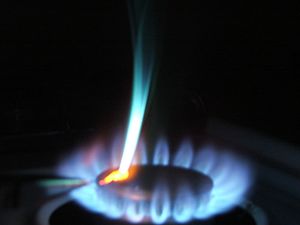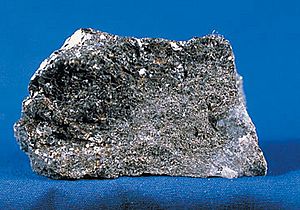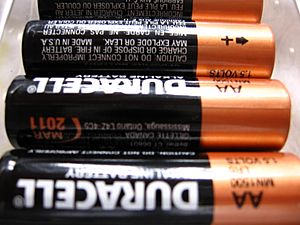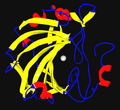Zinc facts for kids
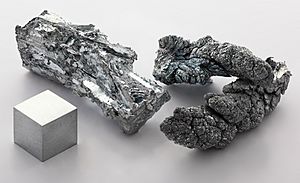 |
|||||||||||||||||||||||||||||||||||||||||||||||||||||||||||||||
| Zinc | |||||||||||||||||||||||||||||||||||||||||||||||||||||||||||||||
|---|---|---|---|---|---|---|---|---|---|---|---|---|---|---|---|---|---|---|---|---|---|---|---|---|---|---|---|---|---|---|---|---|---|---|---|---|---|---|---|---|---|---|---|---|---|---|---|---|---|---|---|---|---|---|---|---|---|---|---|---|---|---|---|
| Appearance | silver-gray | ||||||||||||||||||||||||||||||||||||||||||||||||||||||||||||||
| Standard atomic weight Ar, std(Zn) | 65.38(2) | ||||||||||||||||||||||||||||||||||||||||||||||||||||||||||||||
| Zinc in the periodic table | |||||||||||||||||||||||||||||||||||||||||||||||||||||||||||||||
|
|||||||||||||||||||||||||||||||||||||||||||||||||||||||||||||||
| Atomic number (Z) | 30 | ||||||||||||||||||||||||||||||||||||||||||||||||||||||||||||||
| Group | group 12 | ||||||||||||||||||||||||||||||||||||||||||||||||||||||||||||||
| Period | period 4 | ||||||||||||||||||||||||||||||||||||||||||||||||||||||||||||||
| Block | d | ||||||||||||||||||||||||||||||||||||||||||||||||||||||||||||||
| Electron configuration | [Ar] 3d10 4s2 | ||||||||||||||||||||||||||||||||||||||||||||||||||||||||||||||
| Electrons per shell | 2, 8, 18, 2 | ||||||||||||||||||||||||||||||||||||||||||||||||||||||||||||||
| Physical properties | |||||||||||||||||||||||||||||||||||||||||||||||||||||||||||||||
| Phase at STP | solid | ||||||||||||||||||||||||||||||||||||||||||||||||||||||||||||||
| Melting point | 692.68 K (419.53 °C, 787.15 °F) | ||||||||||||||||||||||||||||||||||||||||||||||||||||||||||||||
| Boiling point | 1180 K (907 °C, 1665 °F) | ||||||||||||||||||||||||||||||||||||||||||||||||||||||||||||||
| Density (near r.t.) | 7.14 g/cm3 | ||||||||||||||||||||||||||||||||||||||||||||||||||||||||||||||
| when liquid (at m.p.) | 6.57 g/cm3 | ||||||||||||||||||||||||||||||||||||||||||||||||||||||||||||||
| Heat of fusion | 7.32 kJ/mol | ||||||||||||||||||||||||||||||||||||||||||||||||||||||||||||||
| Heat of vaporization | 115 kJ/mol | ||||||||||||||||||||||||||||||||||||||||||||||||||||||||||||||
| Molar heat capacity | 25.470 J/(mol·K) | ||||||||||||||||||||||||||||||||||||||||||||||||||||||||||||||
Vapor pressure
|
|||||||||||||||||||||||||||||||||||||||||||||||||||||||||||||||
| Atomic properties | |||||||||||||||||||||||||||||||||||||||||||||||||||||||||||||||
| Oxidation states | −2, 0, +1, +2 (an amphoteric oxide) | ||||||||||||||||||||||||||||||||||||||||||||||||||||||||||||||
| Electronegativity | Pauling scale: 1.65 | ||||||||||||||||||||||||||||||||||||||||||||||||||||||||||||||
| Ionization energies |
|
||||||||||||||||||||||||||||||||||||||||||||||||||||||||||||||
| Atomic radius | empirical: 134 pm | ||||||||||||||||||||||||||||||||||||||||||||||||||||||||||||||
| Covalent radius | 122±4 pm | ||||||||||||||||||||||||||||||||||||||||||||||||||||||||||||||
| Van der Waals radius | 139 pm | ||||||||||||||||||||||||||||||||||||||||||||||||||||||||||||||
| Spectral lines of zinc | |||||||||||||||||||||||||||||||||||||||||||||||||||||||||||||||
| Other properties | |||||||||||||||||||||||||||||||||||||||||||||||||||||||||||||||
| Natural occurrence | primordial | ||||||||||||||||||||||||||||||||||||||||||||||||||||||||||||||
| Crystal structure | hexagonal close-packed (hcp) | ||||||||||||||||||||||||||||||||||||||||||||||||||||||||||||||
| Speed of sound thin rod | 3850 m/s (at r.t.) (rolled) | ||||||||||||||||||||||||||||||||||||||||||||||||||||||||||||||
| Thermal expansion | 30.2 µm/(m⋅K) (at 25 °C) | ||||||||||||||||||||||||||||||||||||||||||||||||||||||||||||||
| Thermal conductivity | 116 W/(m⋅K) | ||||||||||||||||||||||||||||||||||||||||||||||||||||||||||||||
| Electrical resistivity | 59.0 nΩ⋅m (at 20 °C) | ||||||||||||||||||||||||||||||||||||||||||||||||||||||||||||||
| Magnetic ordering | diamagnetic | ||||||||||||||||||||||||||||||||||||||||||||||||||||||||||||||
| Molar magnetic susceptibility | −11.4·10−6 cm3/mol (298 K) | ||||||||||||||||||||||||||||||||||||||||||||||||||||||||||||||
| Young's modulus | 108 GPa | ||||||||||||||||||||||||||||||||||||||||||||||||||||||||||||||
| Shear modulus | 43 GPa | ||||||||||||||||||||||||||||||||||||||||||||||||||||||||||||||
| Bulk modulus | 70 GPa | ||||||||||||||||||||||||||||||||||||||||||||||||||||||||||||||
| Poisson ratio | 0.25 | ||||||||||||||||||||||||||||||||||||||||||||||||||||||||||||||
| Mohs hardness | 2.5 | ||||||||||||||||||||||||||||||||||||||||||||||||||||||||||||||
| Brinell hardness | 327–412 MPa | ||||||||||||||||||||||||||||||||||||||||||||||||||||||||||||||
| CAS Number | 7440-66-6 | ||||||||||||||||||||||||||||||||||||||||||||||||||||||||||||||
| History | |||||||||||||||||||||||||||||||||||||||||||||||||||||||||||||||
| Discovery | Indian metallurgists (before 1000 BCE) | ||||||||||||||||||||||||||||||||||||||||||||||||||||||||||||||
| First isolation | Andreas Sigismund Marggraf (1746) | ||||||||||||||||||||||||||||||||||||||||||||||||||||||||||||||
| Recognized as a unique metal by | Rasaratna Samuccaya (800) | ||||||||||||||||||||||||||||||||||||||||||||||||||||||||||||||
| Main isotopes of zinc | |||||||||||||||||||||||||||||||||||||||||||||||||||||||||||||||
|
|||||||||||||||||||||||||||||||||||||||||||||||||||||||||||||||
Zinc is a shiny, bluish-grey chemical element that is very useful! You might also hear it called spelter. Its symbol on the periodic table is "Zn". Zinc is the 30th element, meaning it has 30 protons and 30 electrons. It's a type of metal called a transition metal.
Zinc is super important because it's used for many things, like protecting other metals from rust (this is called galvanizing) and making batteries. It's actually the fourth most common metal found on Earth!
Contents
What is Zinc Like?
Physical Features of Zinc
Zinc is a shiny, bluish-grey metal. When it's freshly cut, it looks whitish-grey. But if you leave it out in the air, it won't stay shiny for long.
Zinc melts at about 419.58 degrees Celsius (787.24 degrees Fahrenheit) and boils at 907.0 degrees Celsius (1664.6 degrees Fahrenheit). These temperatures are lower than most other transition metals, but higher than metals like tin or lead. You could even melt zinc on a cooking stove! Zinc is not magnetic.
When you warm zinc up a little, it becomes very flexible. This means you can bend and shape it easily. But if you heat it even more, it becomes very brittle and can break easily. Zinc also mixes easily with other metals to form alloys.
How Zinc Reacts (Chemical Properties)
Zinc is a reactive metal. It reacts about as much as aluminium and more than common metals like iron, copper, nickel, and chrome. However, it's less reactive than magnesium.
Zinc can react with acids, bases, and nonmetals. But don't worry, it doesn't rust in the air like iron does! Instead, a thin layer of zinc oxide and zinc carbonate forms on its surface. This special coating actually stops the zinc from getting damaged.
Acids can dissolve this protective coating and then react with the zinc metal itself. When zinc reacts with an acid, it creates a zinc(II) salt (like zinc chloride) and hydrogen gas. This is a very common chemical reaction. For example, with hydrochloric acid:
- Zn + 2HCl → ZnCl2 + H2
If zinc is in a powder form or in small pieces, it can burn to create zinc oxide, which is a white powder. The flame it makes is a bright blue-green color.
- 2 Zn + O2 → 2 ZnO
Zinc oxide can also dissolve in strong bases. This reaction is important in some types of batteries that use zinc.
- ZnO + H2O + 2 OH- → Zn(OH)42-.
Zinc is a "chalcophile" element. This means it prefers to react with sulfur and elements similar to sulfur rather than oxygen. That's why the most common zinc ore is zinc sulfide, not zinc oxide.
Zinc Compounds
Zinc can combine with other elements to form many different chemical compounds. In most of these compounds, zinc has an oxidation state of +2. A +1 compound has been found, but it's very hard to make. There are no other oxidation states for zinc. Most zinc compounds have no color. If they do have a color, it's usually from the other elements, not the zinc itself.
Zinc chloride is one of the most common zinc compounds. It's not very reactive and is a little acidic when dissolved in water. When heated in a fire, it makes a green flame.
Other interesting zinc compounds include:
- Zinc antimonide: A grey material used in electronics.
- Zinc arsenide: An orange material used in electronics.
- Zinc bromide: Used to protect against radiation.
- Zinc carbonate: A natural source of zinc.
- Zinc hydroxide: Used in medical bandages.
- Zinc iodide: Used when taking X-ray pictures.
- Zinc nitrate: Used to help dyes stick to fabric.
- Zinc oxide: Found in sunscreen and paint.
- Zinc phosphate: Used by dentists.
- Zinc sulfate: Used in dyes and paints.
- Zinc sulfide: The most common natural source of zinc.
Where We Find Zinc
Five different types of zinc, called isotopes, are found in nature. The most common one is 64Zn, making up almost half of all natural zinc. This isotope has a very, very long half-life, so its radioactivity is usually ignored. Other natural isotopes are 66Zn, 67Zn, and 68Zn.
You won't find pure zinc metal lying around in the Earth's crust. Zinc is always found combined with other elements in compounds. Sphalerite, a mineral made of zinc sulfide, is the main ore (rock from which metal is extracted) for zinc. Very little zinc is found in the ocean. Zinc ore is often found alongside copper and lead ores.
There are also other zinc ores, like smithsonite (zinc carbonate) and a zinc silicate mineral, but they are less common.
How We Get Zinc
To get zinc from its ore, we first concentrate the zinc sulfide using a process called flotation. A special detergent collects the zinc sulfide, while other impurities sink and are removed. Then, the zinc sulfide is heated in the air to create zinc oxide and sulfur dioxide.
- 2 ZnS + 3 O2 → 2 ZnO + 2 SO2
The sulfur dioxide is then changed into sulfur trioxide.
- 2 SO2 + O2 → 2 SO3
This sulfur trioxide reacts with the zinc oxide to form zinc sulfate. Zinc sulfate is soluble (can dissolve in water), which makes it easier to process.
- SO3 + ZnO → ZnSO4
The zinc sulfate is cleaned and then put through a process called electrolysis. This process uses electricity to separate the zinc sulfate into pure zinc, oxygen, and sulfuric acid. The zinc made this way is very pure and is called "SHG" (special high grade).
- 2 ZnSO4 + 2 H2O → 2 Zn + 2 H2SO4 + O2
The sulfuric acid created can be reused to help get more zinc oxide from the ore.
Another way to get zinc is by heating zinc oxide with carbon at very high temperatures. This process, similar to how iron is made, creates zinc metal and carbon dioxide.
- 2 ZnO + C → 2 Zn + CO2
This method makes cheaper zinc, but it's not as pure.
About 10 million tons of zinc are produced every year, making it the fourth most common metal in the world.
What Zinc is Used For
Zinc as a Metal
Zinc is used in many types of batteries, especially alkaline and Leclanche cells. In batteries, zinc gets oxidized (loses electrons), which helps the battery produce electricity.
A lot of zinc (about 59%) is used to prevent corrosion, which means stopping metals from rusting or breaking down. About 47% of the world's zinc is used for galvanizing. This is a process where a layer of zinc is put on another metal, usually iron, to protect it. The zinc coating corrodes instead of the iron.
There are two main ways to galvanize metal:
- Hot-dipping: The metal is dipped into a pot of melted zinc. This method lasts longer but can make the surface look a bit uneven.
- Electroplating: A thin layer of zinc is applied using electricity.
Zinc is also used in motorboats and pipelines to slow down rust. For example, a motorboat might have a "bullet" of zinc that corrodes easily, protecting other metal parts of the motor from rust.
Zinc is also mixed with other metals to create alloys. Brass, an alloy of copper and zinc, is the most common zinc alloy. Zinc can form alloys with many different metals. Zinc aluminium is an alloy of zinc and aluminium that is good for bearings (parts that help things move smoothly). Even some types of bronze contain zinc. Sometimes, zinc is used to make cadmium zinc telluride, which is a semiconductor (a material that conducts electricity in a special way). Nickel silver is another alloy that contains zinc.
Zinc is also used in the pipes of some pipe organs. In the past, a mix of tin and lead was used. In the United States, modern pennies have a thin layer of copper over a core made of zinc. Older pennies were made entirely of bronze.
A mixture of powdered zinc and sulfur can even be used to power a model rocket! This reaction creates zinc sulfide, heat, light, and gases. Zinc sheet metal is also used to make zinc bars.
Zinc in Compounds
About a quarter of all zinc is used to make zinc compounds. For example, zinc oxide is used in sunscreen to protect your skin from the sun and as a pigment (color) in paint. Zinc oxide is also a semiconductor.
Zinc chloride is used to preserve wood, stopping it from rotting. Some fungicides (chemicals that kill fungi) also contain zinc. Zinc sulfate is used in dyes and pigments. Zinc sulfide is used in fluorescent bulbs to change ultraviolet light into light we can see.
Zinc and Your Body (Biology)
Humans need a small amount of zinc to stay healthy. If people don't get enough zinc from their food, they can develop a mineral deficiency. Almost two billion people worldwide don't get enough zinc. A lack of zinc can make you more likely to get infections.
Some people believe that taking more zinc can help when you have a cold, while others say it doesn't make a difference. There are medicines available for colds that contain zinc. To make sure people get enough zinc, tiny amounts of zinc compounds are often added to vitamin pills and cereals. Most multi-vitamin tablets contain zinc.
Zinc is found in at least 100 different enzymes (special proteins that help your body's chemical reactions). It's the second most common transition metal in the human body, after iron. Zinc is also important for your brain. The human body usually contains about 2 to 4 grams of zinc. A zinc enzyme helps remove carbon dioxide from your blood. Wheat is also a good source of zinc.
Is Zinc Safe?
Eating very large amounts of zinc metal can be toxic (harmful) because it can dissolve in your stomach acid. If you eat too much zinc, it can lower the levels of copper and iron in your body. Some zinc compounds can also be irritating to the stomach. Putting zinc compounds in your nose can even damage your sense of smell.
Zinc ions (charged zinc atoms) are very harmful to fish and many other living things in water.
| Periodic table | |||||||||||||||||||||||||||||||||||||||||
|---|---|---|---|---|---|---|---|---|---|---|---|---|---|---|---|---|---|---|---|---|---|---|---|---|---|---|---|---|---|---|---|---|---|---|---|---|---|---|---|---|---|
| H | He | ||||||||||||||||||||||||||||||||||||||||
| Li | Be | B | C | N | O | F | Ne | ||||||||||||||||||||||||||||||||||
| Na | Mg | Al | Si | P | S | Cl | Ar | ||||||||||||||||||||||||||||||||||
| K | Ca | Sc | Ti | V | Cr | Mn | Fe | Co | Ni | Cu | Zn | Ga | Ge | As | Se | Br | Kr | ||||||||||||||||||||||||
| Rb | Sr | Y | Zr | Nb | Mo | Tc | Ru | Rh | Pd | Ag | Cd | In | Sn | Sb | Te | I | Xe | ||||||||||||||||||||||||
| Cs | Ba | La | Ce | Pr | Nd | Pm | Sm | Eu | Gd | Tb | Dy | Ho | Er | Tm | Yb | Lu | Hf | Ta | W | Re | Os | Ir | Pt | Au | Hg | Tl | Pb | Bi | Po | At | Rn | ||||||||||
| Fr | Ra | Ac | Th | Pa | U | Np | Pu | Am | Cm | Bk | Cf | Es | Fm | Md | No | Lr | Rf | Db | Sg | Bh | Hs | Mt | Ds | Rg | Cn | Uut | Fl | Uup | Lv | Uus | Uuo | ||||||||||
|
|||||||||||||||||||||||||||||||||||||||||
Images for kids
-
Sphalerite (ZnS) is a common zinc ore.
-
Andreas Sigismund Marggraf was the first to get pure zinc.
-
Galvanizing was named after Luigi Galvani.
See also
 In Spanish: Zinc para niños
In Spanish: Zinc para niños




